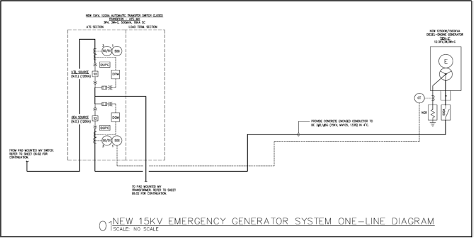“Your success is determined by your ability to find solutions.” – Anonymous
The purpose of this article is to provide an explanation of the emergency power testing during the commissioning process of a new cancer treatment facility. The facility opened in early 2017 with only the fire pump, life safety systems, some equipment circuits, and some critical receptacles served by the backup generator. Due to the power outages in the area where the building is located and the nature of the oncology treatments that the facility performs, it quickly became evident that the entire facility needed to have reliable backup power. Because the facility could not be shut down for the length of time required to replace and re-commission a new, larger generator, it was decided to install a separate generator that served the normal power switchgear. While the existing generator was sized to handle the critical and life safety loads only, the new generator was sized to handle the entire building.
Emergency Generator Backup Power Supply
The new generator was sized to handle the whole facility because the new sequence called for the existing automatic transfer switches to transfer back to Source 1 when utility power was restored. In this instance, Source 1 was still fed from the new generator, Gen-2, because the new transfer switch required a manual transfer back to utility power. The reason to manually transfer back to utility power was two-fold. First, it was desired to avoid any additional outages to the facility and second, the doctors wanted to have the ability to finish all treatment cases for the day and power down the equipment before transferring from generator power to utility power.


The new generator was sized to handle the whole facility because the new sequence called for the existing automatic transfer switches to transfer back to Source 1 when utility power was restored. In this instance, Source 1 was still fed from the new generator, Gen-2, because the new transfer switch required a manual transfer back to utility power. The reason to manually transfer back to utility power was two-fold. First, it was desired to avoid any additional outages to the facility and second, the doctors wanted to have the ability to finish all treatment cases for the day and power down the equipment before transferring from generator power to utility power.

To avoid a second momentary power loss when transferring the facility back to utility power, a closed-transition automatic transfer switch (ATS-MV) was installed. This type of transfer switch utilizes a “make-before-break” transition, where the utility breaker is closed before the generator breaker is opened. This brief overlap allowed the load to transfer from generator power to utility power without any disruption to sensitive equipment in the facility.
Emergency Power System Testing
During the integrated systems test for this sequence it was important to observe the typical MEP systems in the facility to ensure a seamless transition was made. However, in addition to these systems, the facility personnel who operate the oncology treatment equipment were onsite to ensure the equipment was not affected by the power transfers. Due to the sensitivity of the equipment the facility personnel powered down all the equipment before utility power was disconnected to the building. After the initial transfer to generator power by the existing ATSs and the new ATS-MV, the equipment was powered back on.
The facility operated for an hour with the emergency, critical, and life safety switchgear served by the existing generator and the normal power switchgear served by the new generator. During this time, while EAB personnel verified all building systems (emergency and normal) were operating correctly, the facility personnel ensured that the equipment was operating correctly.
Once all systems were verified, the emergency, critical, and life safety ATSs were transferred back to the normal switchgear feed using a manual transfer button found in the emergency power room. Since ATS-MV was still fed by Source 2, this allowed all building systems to be powered by the new generator, Gen-2. Again, EAB personnel confirmed all MEP systems were operating properly while the facility personnel verified the equipment was functional.
Finally, utility power was restored to ATS-MV. Since the ATS was programmed for a closed transition the ATS remained on generator power until the manual transfer could be initiated. During the final closed transfer back to utility power, the facility equipment remained operable to verify that no disruption would be caused by the transfer. This is not the standard procedure for the last transfer as stated above; however, it was important to verify that the ATS could be transferred back to utility without a disruption to the building systems. After the ATS was manually transferred back to utility power, it was confirmed that all power systems remained operational during the transfer.
In conclusion, it should be noted that all manual power transfers and the disconnecting and reconnecting of utility power are performed by an employee of the electrical contractor who follows his company’s safety protocols for such procedures. This system was unique in design to satisfy the specific needs of the client. EAB employees were fortunate to be involved in the design and with developing the sequencing of the automatic transfer switches and the generators. Most importantly, the testing of the sequences was successful.
